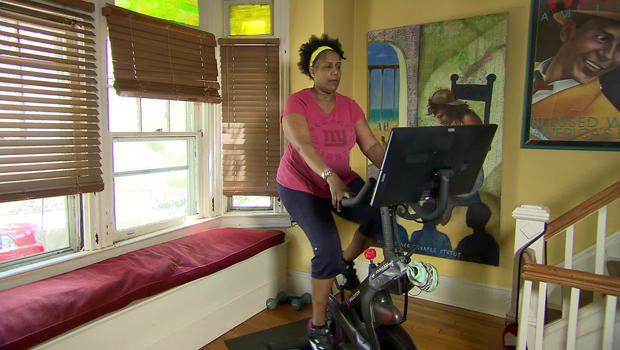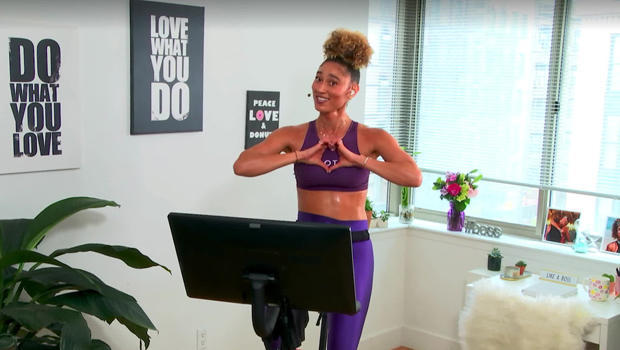On a ride with Peloton
[ad_1]
Back in early March, I got a Peloton bike. I was going to do a story on the fitness company, so they gave me a loaner to try out.
Then came the pandemic, and I was stuck at home – but I still had a job to do.
It wasn’t easy. “I’m out of breath, and I’ve only been at this for a minute and 10 seconds!”
CBS News
You may have heard of Peloton when its holiday ad last year was criticized as “sexist and dystopian,” and widely mocked.
But now with gyms still closed in many places, at-home fitness is more in-demand. And that’s made Peloton one of the few companies to prosper in this economy. Compared to last year, sales are up 66%.
“The tailwind of COVID is undeniable,” said Peloton’s founder and CEO John Foley. “But it is a little bit awkward that we are profiting from this situation.”
Foley started the company in 2012 with small investors and a Kickstarter campaign.
“It usually takes us seven days to deliver a bike. Now, it’s taking us seven weeks to deliver,” he said. “
Giles asked, “Do your deliver guys, and women, do they get paid sick leave?”
“We absolutely have generous sick leave. We also have what’s called ‘hazard pay.’ We heard some other delivery companies that were giving them $2 an hour more or something for hazard pay. We just said, ‘What about $100 a day more, for everyone who is going out there and greeting our members in this environment?’ It felt right.”
And it seems like Peloton can afford it. The bike sells for an eye-popping $2,200, plus a $39-a-month subscription.
But it’s not really the bike, or their $4,000 treadmill, that’s the real attraction. It’s actually the classes: Group cycling, running, yoga, and strength training are all streamed from Peloton’s studios right to your home.
But like so many other workplaces, the studios are now shuttered. And they’ve had to improvise.
Ally Love is one of the instructors. “I get to get up, go in my living room, get on a bike, and somehow there’s a camera that everyone can see me from my house. We’re having a pop party in my living room! When I talk about a house party now, it will never be the same.”
Working out, she’s part personal trainer, part self-help guru.
Peloton
Giles asked, “You have such a positive energy. How are you dealing with this pandemic? I know it’s wearing on me.”
“So, there’s been something that I’ve been saying to myself and to others, is that it’s okay not to be okay,” said Love. “I don’t know what the future looks like. I allow myself to feel all the feels.”
If this all sounds a bit spiritual, well, that’s not an accident to CEO John Foley.
“I was noticing that organized religion was on the decline statistically,” he said. “And I did see that, with boutique fitness, in general people really embrace it. And the congregation and the community and the ritual somebody talking to you from a pulpit for 45 minutes, it’s a healthy religion. I mean, you get the endorphins, you get the community, you get the connection.”
And the next step in their business? “I see tens of millions of global subscribers and members,” Foley said. “It feels like we are Amazon in 1999.”
We’ll see. So far, the company has sold almost a million bikes and treadmills. But there are lots of other options for working out at home right now, and most are less expensive. And let’s be honest, over the years, we’ve seen all sorts of fads for getting in shape at home. [And I should know – I’ve bought most of them, as I explained on “Sunday Morning” a few years ago.]
But when it was time to return the loaner, I didn’t want to give it back. I was actually working out, and I could even take a bike ride with my friends, like “Sunday Morning” editor Ed Givnish, all in a very disconnected time.
So, full disclosure, in 18 monthly payments it’ll be mine.
Will pedaling myself into a sweaty frenzy make a difference? I don’t know. But you know what they say: in the end it’s not really about the destination, it’s about the ride.
For more info:
Story produced by Dustin Stephens. Editor: Ed Givnish.
[ad_2]
Source link












